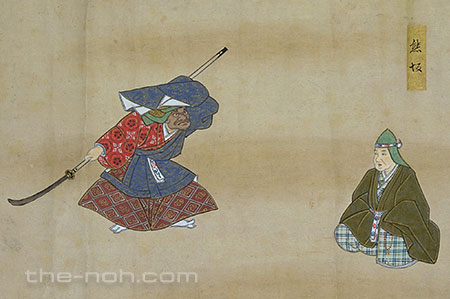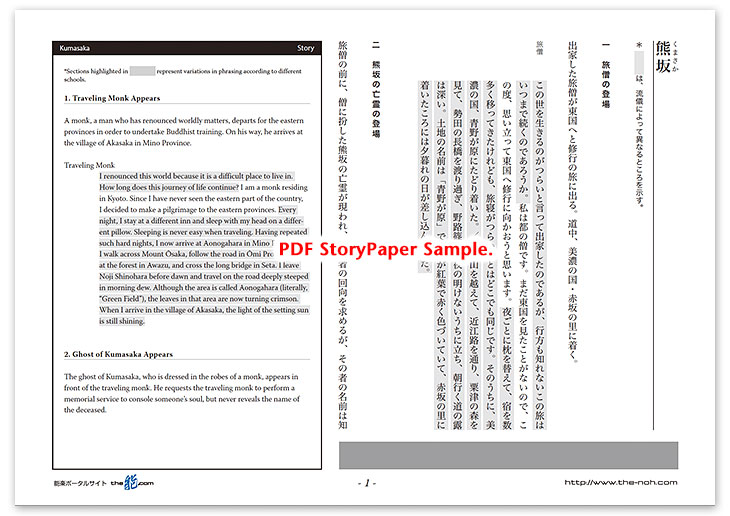
 Kumasaka
Kumasaka

![]()
A monk leaves Kyoto in order to undertake a pilgrimage in the eastern provinces. On his journey, he arrives at Aonogahara in Mino Province, where a monk approaches and talks to him. The monk asks the traveling monk to perform a memorial service for someone today because it is the anniversary of his death. Although the traveling monk wonders why it is not revealed for whom he has been asked to perform the ceremony, he recites a sutra and transfers the merits of his recitation to the soul of the deceased. At night, he enters the Jibutsudō, a temple enshrining Buddhist statues reserved for monks’ practices, and finds that numerous weapons are stored there, including a large long-handled sword and iron rods, instead of Buddhist statues and paintings. The traveling monk is quite surprised, but the other monk explains that as gangs of bandits and thieves have attacked the residents of this area, he has stockpiled these weapons to protect the locals. After hearing his explanation, the traveling monk expects the monk to retire to his bedroom, but the monk vanishes into thin air together with his humble hut. The traveling monk is puzzled by this strange event.
The traveling monk meets a local man and asks him if in the past, someone had committed evil deeds in this vicinity. The villager tells him about Kumasaka Chōhan and encourages the monk to offer prayers to console his soul.
Around dawn, the ghost of Kumasaka Chōhan, who earlier had appeared in the form of a monk, now appears before the traveling monk. His hand holds a long-handled sword and he starts to tell his story. Kumasaka mentions that when Kichiji Nobutaka, a wealthy merchant dealing in gold, passed through this region, he was one of many tough bandits who tried to rob Kichiji’s caravan. However, at that time, Ushiwaka (later known as Minamoto no Yoshitsune), who was travelling with the caravan, fought back against the bandits. Kumasaka and Ushiwaka fought alone against each other, but finally Kumasaka was stabbed and killed by Ushiwaka. Having finished his story, Kumasaka once again asks the traveling monk to perform a memorial service for him and then vanishes into thin air.
![]()
Among a number of Noh plays describing the episodes of Minamoto no Yoshitsune, only a few, such as “Yashima,” make Yoshitsune the lead character (shite). In most of other plays, the role of Yoshitsune is performed by a child actor (kokata). Indeed, in this “Kumasaka,” Yoshitsune does not appear at all and instead, the ghost of Kumasaka Chōhan, the leader of the bandits, relates to the traveling monk his feelings of bitterness against Ushiwaka (Yoshitsune), who killed him. This play adopts the otherworldly, dreamlike structure of mugen Noh.
In the first half of the drama, a traveling monk who has come from Kyoto happens to meet a monk who is a transformation of Kumasaka in lonely, desolate field. It is very unusual that shite (lead actor) and waki (supporting actor) are similar in appearance. They are both dressed in monk's robes, worn in kinagashi-style, and wear no mask. Making them intentionally look alike generates an eerie, uneasy atmosphere. The lead actor does not move much in the first half of the drama, creating the unique ambience in this piece, and the audience is not even told the identity of the lead character during the first half.
The ambience changes dramatically in the second half of the play. The lead actor appears wearing a mask, such as chōreibeshimi, and a hood called chōhan-zukin, and is holding a long-handled sword. He looks exactly like the leader of a band of thieves. The lead character, Kumasaka, moves across the stage freely to fully describe the scenes of his battle with Yoshitsune. The last scene, in which Yoshitsune jumps up lightly and slashes Kumasaka, is especially entertaining with a series of eye-catching movements, such as Kumasaka leaping up and sitting cross-legged in mid-air. On one hand, the tempo beat out by a drum emphasizes the random vigor of the fierce battle scene. On the other hand, it simultaneously expresses the sadness of Kumasaka, a man whose life is meeting its end.
In the first half, the two monks quietly face each other in a humble hut, while in the second half, Kumasaka dances, making sweeping motions with his long-handled sword. The clear contrast between the first and the second halves makes this drama unique and entertaining.
The bandit Kumasaka Chōhan is also featured in another Noh play, “Eboshi-ori” which describes him while still in the prime of life. This piece of genzai Noh (a play depicting real-world events) is called “Genzai Kumasaka (Living Kumasaka).” In contrast, the Kumasaka of this mugen Noh play, in which his ghost appears, is sometimes called “Yūrei Kumasaka (the Ghost Kumasaka)”.
STORY PAPER : Kumasaka
Story Paper presents noh chant stories in modern speech, with story outlines, highlights and more using Adobe PDF format, which can print out and zoom in. Print out the pages and take them with you when you see the actual noh performance.

The copyright of Story Paper is held by the Noh.com. Story Paper is for individual use only. It is prohibited by the copyright law to distribute or publish printed-out Story Paper pages without prior consent. For more information, check the credit and disclaimer pages.



 [Kumasaka : Story Paper PDF : 546KB
[Kumasaka : Story Paper PDF : 546KB